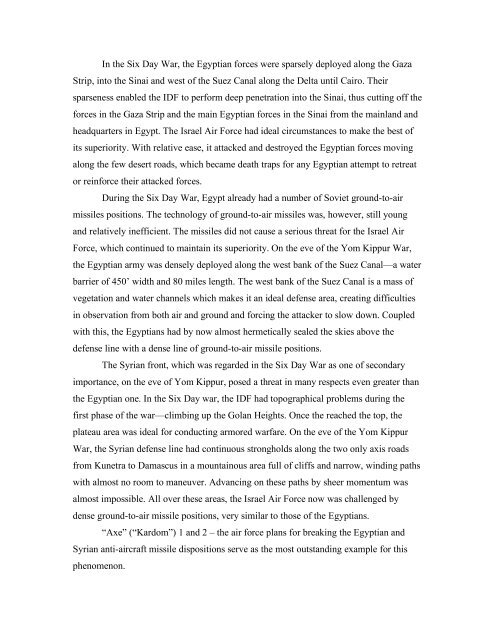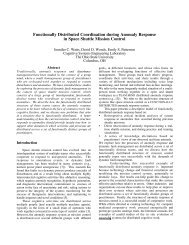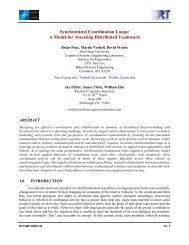Fundamental Surprises Zvi Lanir Decision Research 1201 Oak ...
Fundamental Surprises Zvi Lanir Decision Research 1201 Oak ...
Fundamental Surprises Zvi Lanir Decision Research 1201 Oak ...
- No tags were found...
Create successful ePaper yourself
Turn your PDF publications into a flip-book with our unique Google optimized e-Paper software.
In the Six Day War, the Egyptian forces were sparsely deployed along the Gaza<br />
Strip, into the Sinai and west of the Suez Canal along the Delta until Cairo. Their<br />
sparseness enabled the IDF to perform deep penetration into the Sinai, thus cutting off the<br />
forces in the Gaza Strip and the main Egyptian forces in the Sinai from the mainland and<br />
headquarters in Egypt. The Israel Air Force had ideal circumstances to make the best of<br />
its superiority. With relative ease, it attacked and destroyed the Egyptian forces moving<br />
along the few desert roads, which became death traps for any Egyptian attempt to retreat<br />
or reinforce their attacked forces.<br />
During the Six Day War, Egypt already had a number of Soviet ground-to-air<br />
missiles positions. The technology of ground-to-air missiles was, however, still young<br />
and relatively inefficient. The missiles did not cause a serious threat for the Israel Air<br />
Force, which continued to maintain its superiority. On the eve of the Yom Kippur War,<br />
the Egyptian army was densely deployed along the west bank of the Suez Canal—a water<br />
barrier of 450’ width and 80 miles length. The west bank of the Suez Canal is a mass of<br />
vegetation and water channels which makes it an ideal defense area, creating difficulties<br />
in observation from both air and ground and forcing the attacker to slow down. Coupled<br />
with this, the Egyptians had by now almost hermetically sealed the skies above the<br />
defense line with a dense line of ground-to-air missile positions.<br />
The Syrian front, which was regarded in the Six Day War as one of secondary<br />
importance, on the eve of Yom Kippur, posed a threat in many respects even greater than<br />
the Egyptian one. In the Six Day war, the IDF had topographical problems during the<br />
first phase of the war—climbing up the Golan Heights. Once the reached the top, the<br />
plateau area was ideal for conducting armored warfare. On the eve of the Yom Kippur<br />
War, the Syrian defense line had continuous strongholds along the two only axis roads<br />
from Kunetra to Damascus in a mountainous area full of cliffs and narrow, winding paths<br />
with almost no room to maneuver. Advancing on these paths by sheer momentum was<br />
almost impossible. All over these areas, the Israel Air Force now was challenged by<br />
dense ground-to-air missile positions, very similar to those of the Egyptians.<br />
“Axe” (“Kardom”) 1 and 2 – the air force plans for breaking the Egyptian and<br />
Syrian anti-aircraft missile dispositions serve as the most outstanding example for this<br />
phenomenon.









